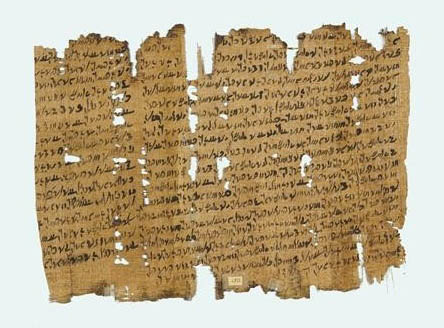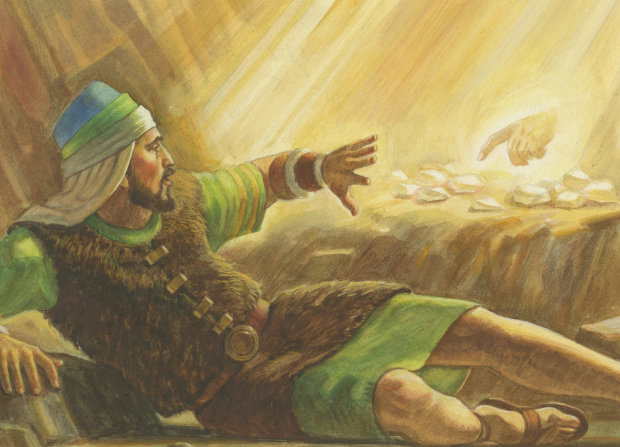Question
Gramps,
In Alma 17:2, it says that the sons of Mosiah had studied the scriptures: what form was their scriptures? And, how many people actually had scriptures at that time? Were they privy to the scriptures because they are sons of the king? Was their only one form of the scriptures and all the people who wanted to study them had to go to a common tent and there could read them? In what language were the scriptures written? Any answers at all about the scriptures at that time? Thanks, Gramps!!
Cheryl
Answer
Cheryl,
Excellent questions. I look forward to going down the rabbit hole with you. Our starting point is when Nephi and his brethren went back to retrieve the Brass Plates.
We know that records were kept on metal plates of various types. They were in the proto-iron age. This meant that bronze was already common, and various forms of iron/steel were being used as well. But even though the technology was there, the refining, alloying, and forging processes were still very energy and time-intensive. So, to write on metal was an expensive rarity.
Nephi’s family seemed to be versed in Egyptian culture and was used in the creation of the Plates of Nephi.
Yea, I make a record in the language of my father, which consists of the learning of the Jews and the language of the Egyptians.
As far as we can tell, the family of Lehi were tradesmen of some sort. They could have been common merchants or they could have been craftsmen themselves. So, they probably traded all around the region.
Egyptians used both stone and clay, as well as papyrus. But the secrets of creating papyrus was a closely guarded secret. And the durability of papyrus, of course, could not compete with stone. So most Bronze/Iron age records we have from the Old World are written in stone.
Nephi and his brethren were required to go all the way back to Jerusalem to get the Brass Plates from Laban because he was the only one who had them. Even though Lehi was an extremely wealthy man, he didn’t have a metal plate copy of the scriptures for himself. So, metal plates were extremely rare and expensive.
We know that in the Old World, metal records were created in both plate and scroll form. The Etruscans, the Pyrgi, and the Phoenicians used to write on metal. This would include a copper scroll found with the Dead Sea Scrolls. We also know that the Jews wrote on wood planks or boards (Ez 37:15-20)
In the New World, we have pre-Columbian records found in stone, & bark-paper. We also know through the Book of Mormon that metal plates were also used (2 Ne 5; Mosiah 1: 3, 4, & 6; Alma 37, et. al.)
So, that helps us understand what forms formal written records may have taken. But you also asked how common it would be to have access to scriptures in whatever form. And that is a question for which we have a direct scriptural answer.
We know through repetition that the prophets and various stewards of the Nephite records had access to metal plates. We also know through history that stone, clay, and various forms of paper were used. The stone may have survived. But it was cumbersome to write on. So much so that many of the ancient languages were written right to left because the right hand was wielding the hammer as the left hand held the chisel. It would have been unheard of to see a left-handed scribe on stone. Thus, it was not a widespread method of writing available to the common man. And it isn’t like you could carry a copy of the scriptures around on stone or even a complete set of metal plates.
Clay was cheaper and easier. But they were preserved by wrapping a copy in cloth or other protective layer with another layer of clay outside to help protect it. If there was a dispute about copies written on paper, the outer clay was opened. And the inner protected stone or clay record was the document of record. But again, this could not be carried around by missionaries.
One thing to keep in mind is that the Nephites would have only had access to the Old Testament books up to Habukkuk. All the other books were written after they left Jerusalem (taking into account the chronological writing order of the books rather than the order as compiled in our Bibles today). And of those books, they may have only carried the Pentateuch (the Torah). So, the copies they carried around were much shorter than our Old Testament. To the ancient Israelites, the Torah is their scripture. Other books were historical and had prophecies. But the Torah was what was venerated as their holy scriptures.
Papyrus was more portable. But in the Old World, it was expensive because it could not be easily made by any people other than the Egyptians. Many others had crude imitations. But they were of much worse quality and durability. They were of little practical use.
So, what was the common method of writing scriptures? We have just a couple of clues. Because the family were tradesmen (not just merchants, but people of trades like forging tools as Nephi did) they had some understanding of manufacturing of that era. If they spent enough time in Egypt to have been schooled by Egyptians, it is entirely possible that they picked up a few things from the Egyptians in the creation of papyrus. And whatever they were not taught, they could probably figure out because the process is not all that difficult to figure out. Those methods closely resemble the methods of manufacturing bark-paper found in the Meso-American era of the New World. Such paper would have served its purpose of providing literature to much of the population.
When King Benjamin could not be heard by all the people who had gathered, he caused his words to be written down and distributed (Mosiah 2:8). This was probably not a stone or clay record which is difficult to distribute. But it seemed to be a more portable medium – like paper.
Abinadi, apparently was a common man, as was Amulek. Yet they knew the scriptures well enough to school the lawyers and priests. It is likely that their scriptures were on much more common and affordable bark-paper.
In addition to all this, there was a method of reading scriptures among the Israelites that was undoubtedly kept by the Nephites who continued to abide by the Law of Moses.
18 Therefore shall ye lay up these my words in your heart and in your soul, and bind them for a sign upon your hand, that they may be as frontlets between your eyes.
19 And ye shall teach them your children, speaking of them when thou sittest in thine house, and when thou walkest by the way, when thou liest down, and when thou risest up.
20 And thou shalt write them upon the door posts of thine house, and upon thy gates:
21 That your days may be multiplied, and the days of your children, in the land which the Lord sware unto your fathers to give them, as the days of heaven upon the earth.
–Deut 11:18-21
The Book of Deuteronomy (which means “Second Law” or sometimes “Second stating of the Law” or “Repetition of the Law”) was written because the Israelites had now had some experience living under the Law (of Moses). But during that time, many questions had come up on the practical application of the law. So, to summarize all the answers to the questions, Deuteronomy was given as a reference for clarifications and solutions.
One concern the Israelites had was that they were commanded to read the Law. They were commanded to teach the Law to their Children. But so few could actually afford to keep a written record, and papyrus was only to be had from Egypt (from whom they had fled) that they didn’t know how to obey this commandment.
The solution was to write parts of the Law anywhere they could by any means they could. They wove it into their clothing. They would carve it into their furniture. They would write on the insides and outsides of their homes. And they would use these forms to help teach their children to read and write as well.
The result was that the Jews became one of the most literate cultures on the planet. Many said that among the Jews, the fisherman was able to hold his own in a religious debate with a priest. While historical records generally indicate a low level of literacy, those records generally speak of people being able to read/write in Greek or Latin (which were the regional and imperial languages respectively).
Obviously, these forms of scriptures (written on the structural members of the houses) were not copies that Nephi could have taken with him into the wilderness. So, they had to have a more compact version. Stone or clay was far too heavy. Paper copies would not have endured. The brass plates were just what the Lord ordered.
Once we get to the New World, they could have written on wood, stone, clay, metal, or bark-paper. And they most certainly wrote words on parts of their homes and clothing. Unfortunately, much of that would have been destroyed upon the destruction of the Nephite nation. That’s what happens when wars are waged upon a God-fearing people. All their scriptures must be destroyed.
Gramps







